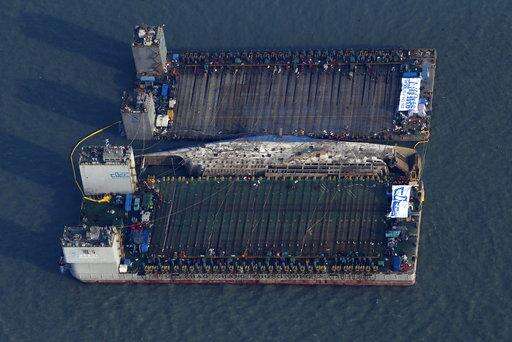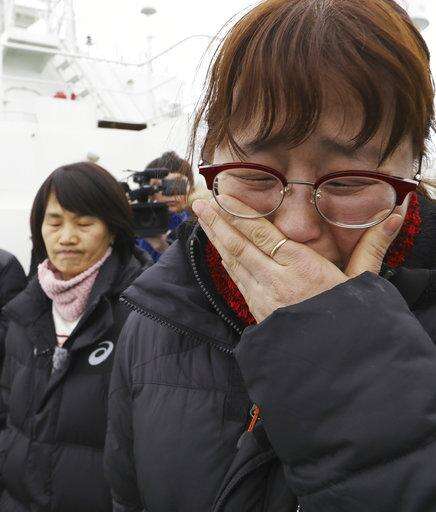Workers try to raise the sunken Sewol ferry between two barges during the salvage operation in waters off Jindo, South Korea, Friday, March 24, 2017. South Korean efforts to bring the sunken, 6,800-ton ferry back to land cleared an obstacle on Friday after divers cut off a vehicle ramp that had been dangling from the ship and hindering efforts to raise it. (Gang Jong-min/Newsis via AP)
The Associated Press
SEOUL, South Korea (AP) - South Korean efforts to bring a sunken, 6,800-ton ferry back to land cleared an obstacle on Friday after divers cut off a vehicle ramp that had been dangling from the ship and hindering efforts to raise it.
Removing the ramp allowed workers to raise the ferry to a height where it can be loaded onto a semi-submersible transport vessel for transportation to a port.
More than 300 people - most of whom were students on a high school trip - died when the Sewol sank on April 16, 2014, touching off an outpouring of national grief and soul searching about long-ignored public safety and regulatory failures. Public outrage over what was seen as a botched rescue job by the government contributed to the recent ouster of Park Geun-hye as president.
Salvage crews raised the Sewol until its upper side was about 13 meters (42 feet) above the water's surface so that they could load it onto the transport vessel about two miles away.
Workers plan to complete loading the ferry by midnight Friday. The waters where the ferry sank are notorious for dangerous currents. The sea is relatively calm now, but currents are forecast to strengthen on Saturday.
Workers on two barges began the salvaging operation Wednesday night, rolling up 66 cables connected to a frame of metal beams divers spent months placing beneath the ferry.
The bodies of 295 passengers were recovered after the sinking, but nine are still missing. Relatives, some of whom were watching from two fishing boats just outside the operation area, hope those remains will be found inside the ferry. Some cried as they watched the emerging wreckage with telescopes.
"I shouted in joy when we heard that the ship surfaced at dawn. I thought we finally can find the missing nine," Lee Geum-hee, the mother of a missing school girl, told a television crew.
"But when I actually saw the ship coming up, I was devastated. All this time my poor child was in that cold, dirty place. It was heart wrenching."
Once the Sewol is loaded onto the transport vessel, it will take about two weeks for it to reach a port 90 kilometers (55 miles) away in the city of Mokpo.
Workers will then begin clearing mud and debris and search for the remains of the missing victims. An investigation committee will also search for clues that could further explain the cause of the sinking, which has been blamed on overloaded cargo, improper storage and other negligence.
The ferry's captain survived and is serving a life sentence after a court found him guilty of committing homicide through "willful negligence" because he fled the ship without issuing an evacuation order.
Ousted President Park was forced to defend herself against accusations that she was out of contact for several hours on the day of the sinking. The allegations were included in an impeachment bill lawmakers passed against Park in December, amid broader corruption suspicions.
Park was formally removed from office by the Constitutional Court earlier this month. She is now under criminal investigation over suspicions that she conspired with a confidante to extort money and favors from companies and allow the friend to secretly interfere with state affairs.
Workers try to raise the sunken Sewol ferry between two barges during the salvage operation in waters off Jindo, South Korea, Thursday, March 23, 2017. The 6,800-ton South Korean ferry emerged from the water on Thursday, nearly three years after it capsized and sank into violent seas off the country's southwestern coast, an emotional moment for the country that continues to search for closure to one of its deadliest disasters ever. (Choi Young-su/Yonhap via AP)
The Associated Press
Relatives of missing passengers of the sunken Sewol ferry on a boat, front, watch its salvage operation in waters off Jindo, South Korea, Thursday, March 23, 2017. South Korean workers on Thursday slowly pulled up the 6,800-ton ferry from the water, nearly three years after it capsized and sank into the violent seas off South Korea's southwestern coast, an emotional moment for a country that continues to search for closure to one of its deadliest disasters ever.(Kyodo News via AP)
The Associated Press

Workers try to raise the sunken Sewol ferry, center, between two barges during the salvage operation in waters off Jindo, South Korea, Thursday, March 23, 2017. The 6,800-ton South Korean ferry emerged from the water on Thursday, nearly three years after it capsized and sank into violent seas off the country's southwestern coast, an emotional moment for the country that continues to search for closure to one of its deadliest disasters ever. (Gang Jong-min/Newsis via AP)
The Associated Press
Workers prepare to lift the sunken Sewol ferry, center, in waters off Jindo, South Korea, Thursday, March 23, 2017. The 6,800-ton South Korean ferry emerged from the water on Thursday, nearly three years after it capsized and sank into violent seas off the country's southwestern coast, an emotional moment for the country that continues to search for closure to one of its deadliest disasters ever. (Park Gyung-woo/Hankookilbo via AP)
The Associated Press
Workers try to raise the sunken Sewol ferry, center, between two barges during the salvage operation in waters off Jindo, South Korea, Thursday, March 23, 2017. A 6,800-ton South Korean ferry emerged from the water on Thursday, nearly three years after it capsized and sank into violent seas off the country's southwestern coast, an emotional moment for the country that continues to search for closure to one of its deadliest disasters ever. (Choi Young-su/Yonhap via AP)
The Associated Press
Workers prepare to lift the sunken Sewol ferry, center, in waters off Jindo, South Korea, Thursday, March 23, 2017. A 6,800-ton South Korean ferry emerged from the water on Thursday, nearly three years after it capsized and sank into violent seas off the country's southwestern coast, an emotional moment for the country that continues to search for closure to one of its deadliest disasters ever. (Park Gyung-woo/Hankookilbo via AP)
The Associated Press
Workers try to raise the sunken Sewol ferry between two barges during the salvage operation in waters off Jindo, South Korea, Thursday, March 23, 2017. The 6,800-ton South Korean ferry emerged from the water on Thursday, nearly three years after it capsized and sank into violent seas off the country's southwestern coast, an emotional moment for the country that continues to search for closure to one of its deadliest disasters ever. (Lee Jin-wook/Yonhap via AP)
The Associated Press
A relative of missing passengers of the sunken Sewol ferry watches workers lifting the boat in waters off Jindo, South Korea, Thursday, March 23, 2017. South Korean workers on Thursday slowly pulled up the 6,800-ton ferry from the water, nearly three years after it capsized and sank into the violent seas off South Korea's southwestern coast, an emotional moment for a country that continues to search for closure to one of its deadliest disasters ever. (Lee Jin-wook/Yonhap via AP)
The Associated Press

A relative of missing passengers of the sunken Sewol ferry cries as she watches workers lifting the boat in waters off Jindo, South Korea, Thursday, March 23, 2017. South Korean workers on Thursday slowly pulled up the 6,800-ton ferry from the water, nearly three years after it capsized and sank into the violent seas off South Korea's southwestern coast, an emotional moment for a country that continues to search for closure to one of its deadliest disasters ever. (Lee Jin-wook/Yonhap via AP)
The Associated Press

A relative of missing passengers of the sunken Sewol ferry weeps as she watches workers lifting the boat in waters off Jindo, South Korea, Thursday, March 23, 2017. South Korean workers on Thursday slowly pulled up the 6,800-ton ferry from the water, nearly three years after it capsized and sank into the violent seas off South Korea's southwestern coast, an emotional moment for a country that continues to search for closure to one of its deadliest disasters ever. (Lee Jin-wook/Yonhap via AP)
The Associated Press
A part of the sunken Sewol ferry is seen in waters off Jindo, South Korea, Thursday, March 23, 2017. Nearly three years after it capsized and sank into the violent seas off South Koreaâs southwestern coast, workers slowly pulled up the 6,800-ton ferry Sewol from the waters on Thursday. (Korea Pool/Yonhap via AP)
The Associated Press
FILE - In this April 16, 2014 file photo, South Korean rescue helicopters fly over South Korean ferry Sewol, trying to rescue passengers from the ship in waters off Jindo, South Korea. Salvage workers are slowly pulling up the huge, corroded South Korean ferry above the sea surface Thursday, March 23, 2017, about three years after it sank on its routine voyage to a resort island, killing more than 300 people, mostly high school students. (Yonhap via AP, File)
The Associated Press

FILE - In this April 16, 2014 file photo released by South Korea Coast Guard via Yonhap News Agency, South Korean coast guard officers rescue ferry Sewol captain Lee Joon-seok, wearing a sweater and underwear, from the ferry in the water off the Jindo, South Korea. Salvage workers are slowly pulling up the huge, corroded South Korean ferry above the sea surface Thursday, March 23, 2017, about three years after it sank on its routine voyage to a resort island, killing more than 300 people, mostly high school students. (South Korea Coast Guard/Yonhap via AP, File)
The Associated Press